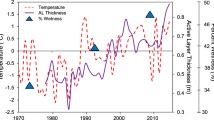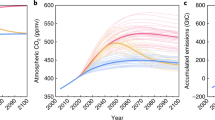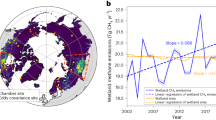Abstract
Purpose of Review
We assess the level of importance of methane (CH4) in the permafrost carbon feedback by reviewing recent scientific publications.
Recent Findings
Studies that consider permafrost degradation in wetlands suggest that CH4 could have a share of ~20% in the warming caused by the total permafrost carbon release by 2100. When CH4 emissions from thermokarst lakes are considered, the contribution from permafrost CH4 to the surface warming increases to between 30 and 50%.
Summary
Based on the reviewed literature, we report that gradual degradation of the near-surface permafrost under unmitigated emissions scenarios could result in an additional warming of ~0.3 (0.08–0.50) °C by 2100, out of which up to 0.1 °C would be from wetland CH4 emissions. However, these values can be underestimates as the degradation of ice-rich permafrost and subsequent CH4 emissions from thermokarst lakes are not accounted for in the calculations.

Similar content being viewed by others
References
Papers of particular interest, published recently, have been highlighted as: • Of importance •• Of major importance
Kirtman B, Power SB, Adedoyin JA, Boer GJ, Bojariu R, Camilloni I, et al. Near-term climate change: Projections and predictability. Climate Change 2013: The physical science basis. Contribution of working group I to the fifth assessment report of the Intergovernmental Panel on Climate Change. Cambridge, UK and New York, NY, USA: Cambridge University Press; 2013. p. 953–1028.
Woo M. Permafrost hydrology. Heidelberg: Springer; 2012.
Kokelj SV, Jorgenson MT. Advances in thermokarst research. Permafr Periglac Process. 2013;24:108–19.
de Grandpré I, Fortier D, Stephani E. Degradation of permafrost beneath a road embankment enhanced by heat advected in groundwater. Can J Earth Sci. 2012;49:953–62.
Hugelius G, Strauss J, Zubrzycki S, Harden JW, Schuur EAG, Ping CL, et al. Estimated stocks of circumpolar permafrost carbon with quantified uncertainty ranges and identified data gaps. Biogeosciences. 2014;11:6573–93.
• Schaefer K, Lantuit H, Romanovsky VE, Schuur EAG, Witt R. The impact of the permafrost carbon feedback on global climate. Environ Res Lett. 2014;9:85003. Is a recent meta-analysis of all studies on the permafrost carbon feedback published before 2014.
Christensen TR, van Huissteden K, Sachs T. Natural terrestrial methane sources in the Arctic. AMAP Assessment 2015: Methane as an Arctic climate forcer. Oslo, Norway: Arctic Monitoring and Assessment Programme (AMAP); 2015. p. 15–26.
•• Schuur EAG, McGuire AD, Grosse G, Harden JW, Hayes DJ, Hugelius G, et al. Climate change and the permafrost carbon feedback. Nature. 2015;520:171–9. Is the most recent comprehensive review on the permafrost carbon feedback.
Ciais P, Sabine C, Bala G, Bopp L, Brovkin V, Canadell J, et al. Carbon and other biogeochemical cycles. Climate Change 2013: The physical science basis. Contribution of working group I to the fifth assessment report of the Intergovernmental Panel on Climate Change. Cambridge, UK and New York, NY, USA: Cambridge University Press; 2013. p. 465–570.
Arora VK, Boer GJ, Friedlingstein P, Eby M, Jones CD, Christian JR, et al. Carbon-concentration and carbon-climate feedbacks in CMIP5 earth system models. J Clim. 2013;26:5289–314.
•• Schneider Von Deimling T, Grosse G, Strauss J, Schirrmeister L, Morgenstern A, Schaphoff S, et al. Observation-based modelling of permafrost carbon fluxes with accounting for deep carbon deposits and thermokarst activity. Biogeosciences. 2015;12:3469–88. Is the single study so far based on model projections of permafrost CO 2 and CH 4 emissions with the consideration of future CH 4 emissions from both wetlands and thermokarst lakes.
Schneider Von Deimling T, Meinshausen M, Levermann A, Huber V, Frieler K, Lawrence DM, et al. Estimating the near-surface permafrost-carbon feedback on global warming. Biogeosciences. 2012;9:649–65.
MacDougall AH, Avis CA, Weaver AJ. Significant contribution to climate warming from the permafrost carbon feedback. Nat Geosci. 2012;5:719–21.
Myhre G, Shindell D, Bréon F-M, Collins W, Fuglestvedt J, Huang J, et al. Anthropogenic and natural radiative forcing. Climate Change 2013: The physical science basis. Contribution of working group I to the fifth assessment report of the Intergovernmental Panel on Climate Change. Cambridge, UK and New York, NY, USA: Cambridge University Press; 2013. p. 659–740.
Isaksen ISA, Gauss M, Myhre G, Walter Anthony KM, Ruppel C. Strong atmospheric chemistry feedback to climate warming from Arctic methane emissions. Glob Biogeochem Cycles. 2011;25:GB2002.
Matthews E, Fung I. Methane emission from natural wetlands: global distribution, area, and environmental characteristics of sources. Glob Biogeochem Cycles. 1987;1:61–86.
Walter KM, Zimov SA, Chanton JP, Verbyla D, Chapin III FS. Methane bubbling from Siberian thaw lakes as a positive feedback to climate warming. Nature. 2006;443:71–5.
Schuur EAG, Bockheim J, Canadell JG, Euskirchen E, Field CB, Goryachkin SV, et al. Vulnerability of permafrost carbon to climate change: implications for the global carbon cycle. Bioscience. 2008;58:701–14.
O’Connor FM, Boucher O, Gedney N, Jones CD, Folberth GA, Coppell R, et al. Possible role of wetlands, permafrost, and methane hydrates in the methane cycle under future climate change: a review. Review of Geophysics. 2010;48
McGuire AD, Anderson LG, Christensen TR, Dallimore S, Guo L, Hayes DJ, et al. Sensitivity of the carbon cycle in the Arctic to climate change. Ecol Monogr. 2009;79:523–55.
Shakhova N, Semiletov I, Leifer I, Salyuk A, Rekant P, Kosmach D. Geochemical and geophysical evidence of methane release over the East Siberian Arctic Shelf. Journal of Geophysical Research: Oceans. 2010;C08007.
Bridgham SD, Cadillo-Quiroz H, Keller JK, Zhuang Q. Methane emissions from wetlands: biogeochemical, microbial, and modeling perspectives from local to global scales. Glob Chang Biol. 2013;19:1325–46.
Saunois M, Bousquet P, Poulter B, Peregon A, Ciais P, Canadell JG, et al. The global methane budget 2000–2012. Earth System Science Data. 2016;8:697–751.
Burke EJ, Hartley IP, Jones CD. Uncertainties in the global temperature change caused by carbon release from permafrost thawing. Cryosphere. 2012;6:1063–76.
Olefeldt D, Goswami S, Grosse G, Hayes D, Hugelius G, Kuhry P, et al. Circumpolar distribution and carbon storage of thermokarst landscapes. Nat Commun. 2016;7:13043.
•• Nauta AL, Heijmans MMPD, Blok D, Limpens J, Elberling B, Gallagher A, et al. Permafrost collapse after shrub removal shifts tundra ecosystem to a methane source. Nat Clim Chang. 2015;5:67–70. Summarizes results from a field experiment on the potential rapid transformation of CH 4 sinks into CH 4 sources following change in vegetation cover and thermokarst development.
•• Walter Anthony K, Daanen R, Anthony P, Schneider von Deimling T, Ping C-L, Chanton JP, et al. Methane emissions proportional to permafrost carbon thawed in Arctic lakes since the 1950s. Nat Geosci. 2016;9:679–82. Highlights the proportionality between thawed carbon eroding into thermokarst lakes and CH 4 emissions from these lakes since the middle of the last century based on field observations.
Strauss J, Schirrmeister L, Grosse G, Wetterich S, Ulrich M, Herzschuh U, et al. The deep permafrost carbon pool of the yedoma region in Siberia and Alaska. Geophys Res Lett. 2013;40:6165–70.
Bastviken D, Tranvik LJ, Downing JA, Crill PM, Enrich-Prast A. Freshwater methane emissions offset the continental carbon sink. Science. 2011;331:50.
Olefeldt D, Turetsky MR, Crill PM, McGuire AD. Environmental and physical controls on northern terrestrial methane emissions across permafrost zones. Glob Chang Biol. 2013;19:589–603.
Treat CC, Natali SM, Ernakovich J, Iversen CM, Lupascu M, McGuire AD, et al. A pan-Arctic synthesis of CH4 and CO2 production from anoxic soil incubations. Glob Chang Biol. 2015;21:2787–803.
Schlesinger WH, Bernhardt ES. Wetland ecosystems. Biogeochemistry: an analysis of global change. 3rd ed. Cambridge, MA, USA: Academic Press; 2013. p. 233–73.
Lofton DD, Whalen SC, Hershey AE. Effect of temperature on methane dynamics and evaluation of methane oxidation kinetics in shallow Arctic Alaskan lakes. Hydrobiologia. 2014;72:209–22.
Schädel C, K-F Bader M. G Schuur EA, Biasi C, Bracho R, Čapek P, et al. Potential carbon emissions dominated by carbon dioxide from thawed permafrost soils Nature Climate Change. 2016;6:950–3.
Kirschke S, Bousquet P, Ciais P, Saunois M, Canadell JG, Dlugokencky EJ, et al. Three decades of global methane sources and sinks. Nat Geosci. 2013;6:813–23.
Bruhwiler L, Bousquet P, Houweling S, Melton J. Modeling of atmospheric methane using inverse (and forward) approaches. AMAP assessment 2015: methane as an Arctic climate forcer. Oslo, Norway: Arctic Monitoring and Assessment Programme (AMAP); 2015. p. 77–90.
Wik M, Varner R, Walter Anthony K, MacIntyre S, Bastviken D. Climate-sensitive northern lakes and ponds are critical components of methane release. Nat Geosci. 2016;9:99–105.
Parmentier F-JW, Silyakova A, Biastoch A, Kretschmer K. Natural marine methane sources in the Arctic. AMAP assessment 2015: methane as an Arctic climate forcer. Oslo, Norway: Arctic Monitoring and Assessment Programme (AMAP); 2015. p. 27–38.
Walter Anthony KM, Anthony P, Grosse G, Chanton J. Geologic methane seeps along boundaries of Arctic permafrost thaw and melting glaciers. Nat Geosci. 2012;5:419–26.
Thornton BF, Crill P. Arctic permafrost: microbial lid on subsea methane. Nat Clim Chang. 2015;5:723–4.
Ruppel C. Permafrost-associated gas hydrate: is it really approximately 1% of the global system? Journal of Chemical and Engineering Data. 2015;60:429–36.
Overduin PP, Liebner S, Knoblauch C, Günther F, Wetterich S, Schirrmeister L, et al. Methane oxidation following submarine permafrost degradation: measurements from a central Laptev Sea shelf borehole. Journal of Geophysical Research: Biogeosciences. 2015;120:965–78.
Dmitrenko IA, Kirillov SA, Tremblay LB, Kassens H, Anisimov OA, Lavrov SA, et al. Recent changes in shelf hydrography in the Siberian Arctic: potential for subsea permafrost instability. Journal of Geophysical Research: Oceans. 2011;116:C10027.
Koven CD, Schuur EAG, Schädel C, Bohn TJ, Burke EJ, Chen G, et al. A simplified, data-constrained approach to estimate the permafrost carbon–climate feedback. Phil Trans R Soc A. 2015;373
Koven CD, Ringeval B, Friedlingstein P, Ciais P, Cadule P, Khvorostyanov D, et al. Permafrost carbon-climate feedbacks accelerate global warming. Proc Natl Acad Sci U S A. 2011;108:14769–74.
• Schuur EAG, Abbott BW, Bowden WB, Brovkin V, Camill P, Canadell JG, et al. Expert assessment of vulnerability of permafrost carbon to climate change. Clim Chang. 2013;119:359–74. Provides the general opinion of expert scientists on a number of questions related to the permafrost carbon feedback as for the last 3 to 4 years.
Schaefer K, Zhang T, Bruhwiler L, Barrett AP. Amount and timing of permafrost carbon release in response to climate warming. Tellus B. 2011;63:165–80.
• MacDougall AH, Zickfeld K, Knutti R, Matthews HD. Sensitivity of carbon budgets to permafrost carbon feedbacks and non-CO2 forcings. Environ Res Lett. 2015;10:125003. Is a recent modelling study on the implications of the permafrost carbon feedback on carbon budgets for the 2°C, 2.5°C and 3°C warming targets.
Lawrence DM, Koven CD, Swenson SC, Riley WJ, Slater AG. Permafrost thaw and resulting soil moisture changes regulate projected high-latitude CO2 and CH4 emissions. Environ Res Lett. 2015;10.
Avis CA, Weaver AJ, Meissner KJ. Reduction in areal extent of high-latitude wetlands in response to permafrost thaw. Nat Geosci. 2011;4:444–8.
McCalley CK, Woodcroft BJ, Hodgkins SB, Wehr RA, Kim E-H, Mondav R, et al. Methane dynamics regulated by microbial community response to permafrost thaw. Nature. 2014;514:478–81.
Melton JR, Wania R, Hodson EL, Poulter B, Ringeval B, Spahni R, et al. Present state of global wetland extent and wetland methane modelling: conclusions from a model inter-comparison project (WETCHIMP). Biogeosciences. 2013;10:753–88.
Turetsky MR, Kane ES, Harden JW, Ottmar RD, Manies KL, Hoy E, et al. Recent acceleration of biomass burning and carbon losses in Alaskan forests and peatlands. Nat Geosci. 2011;4:27–31.
Acknowledgments
K. Zickfeld acknowledges support from the National Sciences and Engineering Research Council of Canada (NSERC) Discovery Grant Program.
Author information
Authors and Affiliations
Corresponding author
Ethics declarations
Conflict of Interest
On behalf of all authors, the corresponding author states that there is no conflict of interest.
Human and Animal Rights
This article does not contain any studies with human or animal subjects performed by any of the authors.
Additional information
This article is part of the Topical Collection on Carbon Cycle and Climate
Rights and permissions
About this article
Cite this article
Nzotungicimpaye, CM., Zickfeld, K. The Contribution from Methane to the Permafrost Carbon Feedback. Curr Clim Change Rep 3, 58–68 (2017). https://doi.org/10.1007/s40641-017-0054-1
Published:
Issue Date:
DOI: https://doi.org/10.1007/s40641-017-0054-1




